The commonalities between these two planets stop at the point of the preceding chapter, because as we approach the differences is obvious.
Unique rotation
The tilt of the rotation axis is 2.64 degrees, so at the equator, the sun deviates little from the vertical, so there is no season. Moreover, the rotation of the planet is unique in the solar system because it is retrograde. Viewed from the “top” (above the Earth’s north pole) of the solar system, Venus rotates clockwise (clockwise) while the other planets rotate in the opposite direction (prograde or direct sense) with the particular case of Uranus which is layered on its axis. For this reason, the axis tilt is rated as 177.36 degrees because the north pole is actually at the “bottom” of the solar system. This hourly rotation is particularly strange because the protoplanetary disk in which the planets formed rotates in the prograde direction, and at its creation, Venus had to rotate in the prograde direction.
Today, the causes of this reversal of the direction of rotation have not been explained but gives rise to several hypotheses such as the gravitational influence of the atmosphere, the tidal effects of the sun or even a giant impact.

In addition to this exceptional sense, the speed of rotation is also particularly slow. A sidereal day 243 Earth days, that is, longer than a year (224.7 earthdays). Seen from the surface, the movement of the sun is due, more to the movement of Venus around the Sun than to the rotation of Venus on itself. However, the coupling of rotation around the sun that is prograde and the rotation on its axis which is retrograde makes the sun pass faster in the sky, and thus reduces the duration of a solar day by 116.75 Earth days. Thus, at one point on the surface, the sun is visible 58.4 earthdays followed by a night of also 58.4 earthdays. The planet’s low rotational speed makes it particularly spherical, it may seem logical, but a fast-rotating planet like the Earth is swollen at the equator and flattened at the pole by centrifugal force.
A hellish atmosphere
The most notable difference between the Earth and Venus remains its atmosphere. Venus’ atmosphere is about 100 times heavier than Earth’s. This produces an surface pressure of 93 bars (compared to about 1 bar at sea level on land), which is equivalent to 1,000m deep in an ocean, thus largely enough to crush a nuclear submarine. The atmosphere is mainly made up of carbon dioxide (96.5%) nitrogen (3.5%) and proceeds a small amount of sulphur oxide, argon, water vapour, carbon monoxide, helium, neon, hydrogen chloride and hydrogen fluoride. The pressure level is such that at the lowest level on the planet, the CO2 on the surface is no longer really gaseous, but in a critical state, that is, intermediate between gas and liquid. The air mass at the surface is estimated at 65kg/m3 compared to 1.225kg/m3 for Earth, it is sufficient for a probe to land without a parachute in the image of an object touching the bottom of a sea.
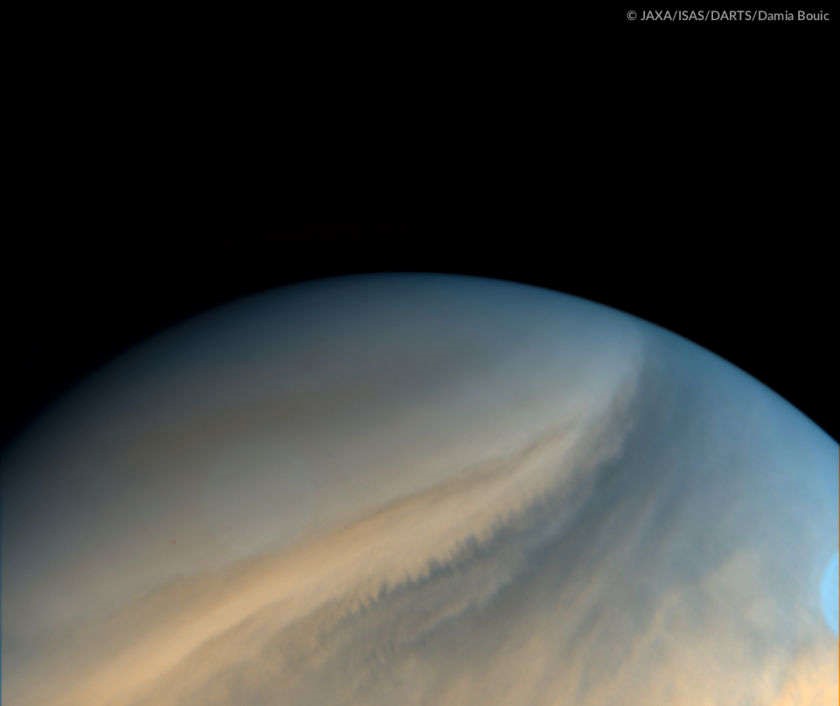
As we know, in light of climate change on Earth, CO2 is a greenhouse gas. This molecule is transparent to the visible ray of the sun, which passes through the atmosphere and warms the surface. However, the triatomic structure of this molecule effectively absorbs the infrared rays that the planet emits to cool down. Since the heat cannot be released, the temperature of the planet increases much more than if there were no atmosphere. The case of Venus is extreme, in fact, its average surface temperature is 462°C (minimum 446°C), it is the highest in the solar system because it is higher than the maximum temperature of Mercury (427°C) yet almost twice as close to the sun but devoid of atmosphere.
However, the situation should be even worse, as 75% of the solar energy it receives is sent back into space before increasing the temperature of the planet. This energy is reflected on various layers of mist and clouds between 40 and 60 km above sea level, and covers the entire planet. This cover hid the surface from the eyes of the Earth until the invention of radar in the 1950s, leaving dreams of extraterrestrial civilization to last. Despite solar energy received by the planet about twice as much as on Earth, the light received on the surface corresponds to what can be observed during an Earth’s sunset. However, reflection on clouds and distortion due to differences in CO2 density depending on altitude, circulate the sun’s rays in a large part of the atmosphere and make light visible long after dusk or before dawn.
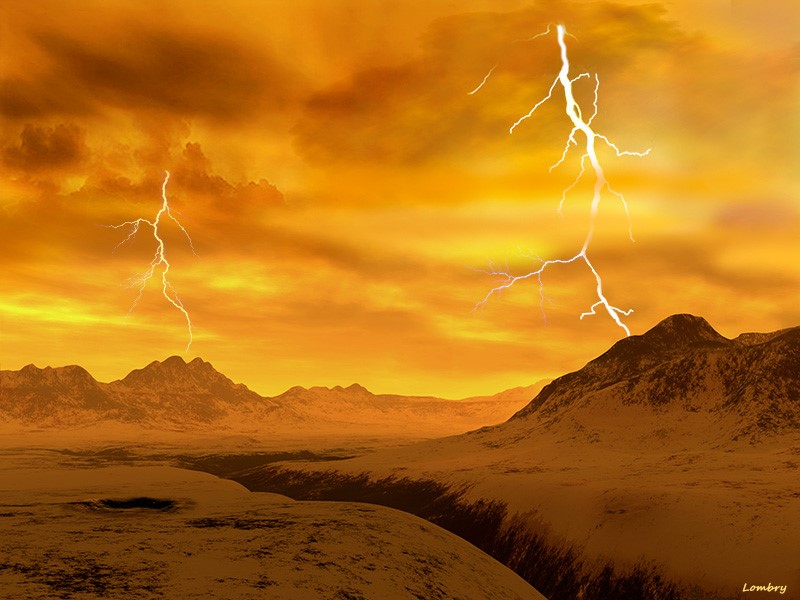
The composition of the clouds fits perfectly into the infernal image of the planet. Instead of being composed of water, these clouds are composed mostly of sulphuric acid. This acid was originally produced by volcanoes but would continue to be produced in a cycle. In the upper atmosphere, CO2 is broken by ultraviolet radiation from the sun into carbon monoxide and oxygen that reacts rapidly with sulphur dioxide present in the trace state to form sulphur trioxide. The latter combines with traces of water vapour to form the sulphuric acid that then circulates in the cloud layers. Sometimes, as on Earth, these clouds cause rain, but no drop of acid reaches the ground. This phenomenon called virga is due to extreme temperatures which, from 30km above reference level, breaks down into water, oxygen and sulphur dioxide. These elements mix with others to form the lower mist layer which remains very little known because hidden by the clouds, we just know that these components tend to rise and ends up in the process of creating sulphuric acid described above and thus closes the cycle. Sulphuric acid movements could lead to lightning strikes and several incidents indicate their presence. But this is still debated because the electrical conductivity of sulphuric acid and mainly horizontal movements are a hindrance to thunderstorms as we know them on Earth.
These horizontal movements are indeed particularly impressive. The atmosphere is literally rotating around the planet at about 350km/h (100m/s), which takes a four-day turn (while the surface takes 243 days). This movement, whose origins are unknown, is not uniform and depends on the altitude and latitude of the winds. At the surface level, the winds are rather slow at about 5 to 10 km/h, but given the density of the air, it can move small stones and create erosion of rocks. The wind speed then steadily winds before remaining constant at about 30m/s (100km/h) from 20 to 40km altitude. The speed follows abruptly at about 100m/s (360 km/h) throughout the cloud area.
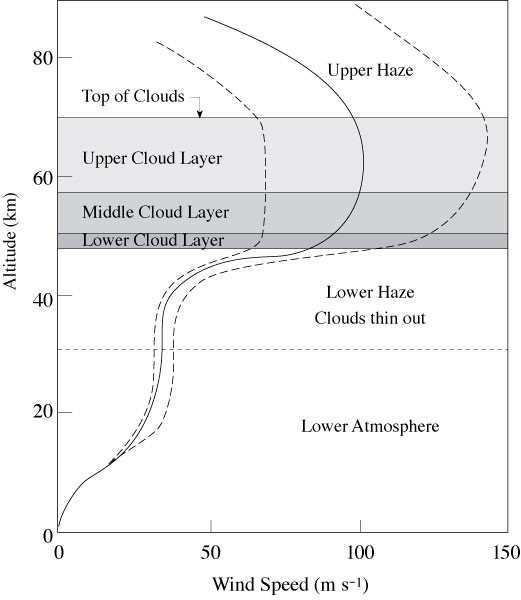
In addition to this westward movement, air also flows towards the poles and the much weaker equator. Indeed, the air heated by the sun at the equator rises and then moves to the poles where it descends, cooling down and then returning to the equator. This phenomenon produces a Hadley cell per hemisphere of which we have relatively little data, but it can be estimated that the reversal of flows is at about 55-60 km altitude.
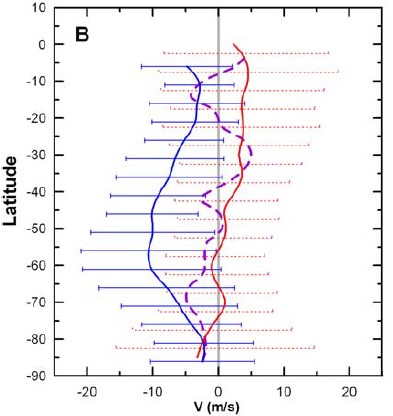
What is described above is mainly valid below 60 degrees latitude. Above, at the poles, the rotating atmosphere leads to a particularly complex system. The most visible manifestation are the famous two-eyed cyclones caused at each pole. This system causes a strong imbalance in the atmospheric parameters of unusual temperatures. Moreover, through these eyes, it is possible to see much deeper in the atmosphere than anywhere else on Venus.
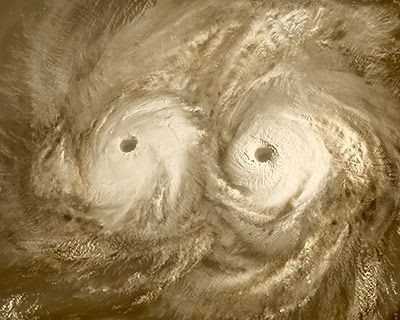
A chaotic surface
The surface, too, is very different from what we know on Earth and completes the infernal picture that Venus offers. This surface has only been studied since the 1950s and the development of radar that allows to see through clouds. The surface consists mainly of basalt plains extending a few km below altitude 0 (medium altitude at the equator), which is very similar to terrestrial ocean boards. Above these plains stand “continents” of volcanic origin caused by land movements. On Venus all geological formations have a female name (mainly goddesses) with the exception of the Maxwell mountain range (named after the Scottish physicist) which contains the highest point of Venus (10.7km above the reference level) and which is located in the centre of Ishtar terra, a “continent” the size of Australia located near the North Pole. The other great “continent” is Aphrodite terra which is the size of Eurasia and extends along the equator to the south. It is easily recognizable by its scorpion shape, whose tail is home to the largest volcano on the planet, Mount Maat.
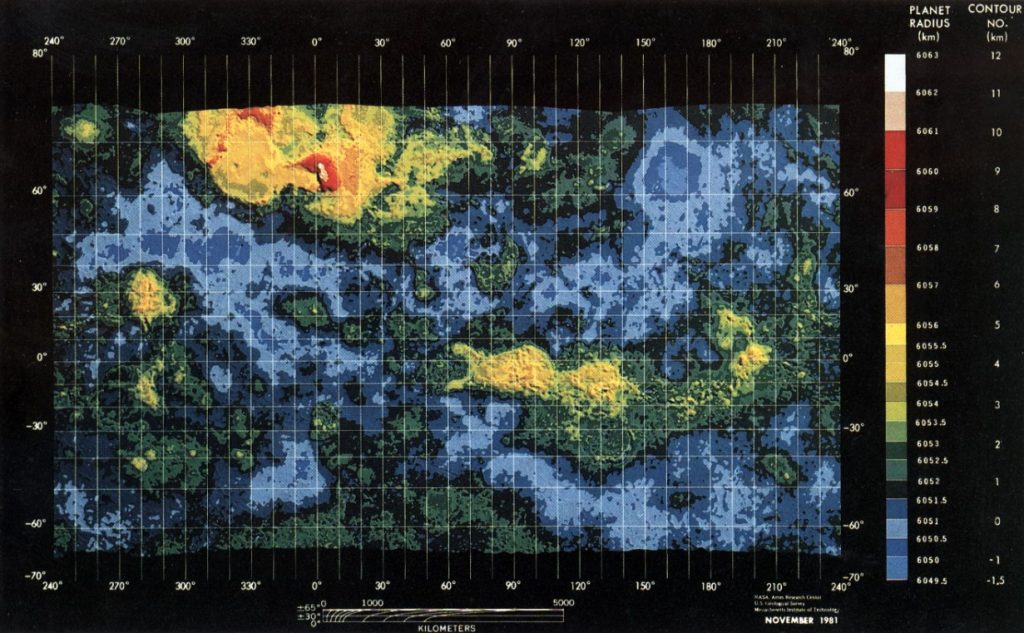
In addition to the plains, plateaus, volcanoes and mountains found on both Earth and Venus, there are typical Venusian geological formations. We can cite the tessera consisting of massifs formed of blocks resembling mosaics and reflecting radar waves better (the only way to scan the Venusian soil) than the surrounding plains and explain that a structure of this type (alpha region) is one of the first geological elements identified on Venus, in 1964. It is believed to be due to the fragmentation of older plateaus. These types of terrain are found at many points of Aphrodite terra and in the eastern part of Ishtar terra in the Fortuna tessera which are the oldest known lands on Venus. Recent study lets thought that the precursor terrain would have been formed in the presence of water, so will be of ancient ocean floor.
Another formation found almost exclusively on Venus are the Corona and its variants. A corona is a circular formation consisting of a series of concentric ridges (like the waves created by a pebble in a pond) with a diameter ranging from a hundred kilometers up to 2,600km for the largest, Artemis corona. It usually consists of a large central dome surrounded by a recess itself enserated in a peripheral bulge. In the center of the dome can be found a number of volcanic buildings as often a large caldera. According to current information, these coronas are due to the presence of a magmatic hot spot just below the surface exerting radial pressure on the already present terrain.
There are two variants of coronas, the first are arachnoids which are relatively small and low-marked coronas but have fractures that radiate from its center and go beyond the peripheral bulge. The other, more distinct formations are the farrum, which have a pancake shape, consist only of a central dome and are probably due to the emergence of particularly viscous magma.
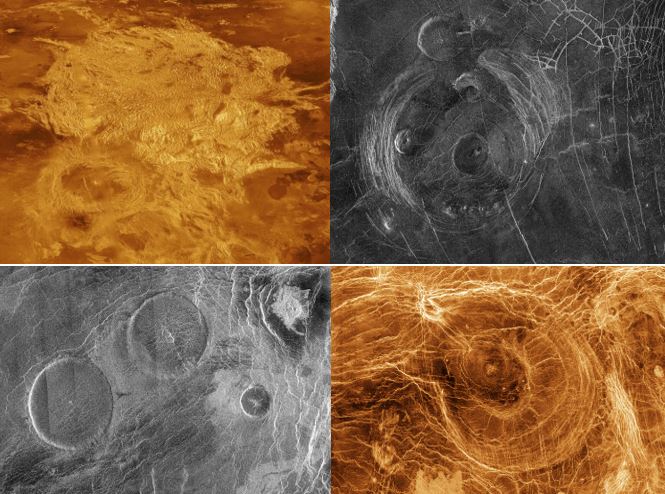
at the top left: Tessera (source)
at the top right: Corona (source)
at the bottom left: farrum (source)
at the bottom right: arachnoid (source)
Although very little data exist on geological functioning, there are a number of possible explanations for this particular functioning. Unlike Earth, Venus has no plate tectonics that evokes heat due to internal radioactivity in linear volcanic structures (dorsal, ring of fire) and causes one-way movements of terrain. On Venus, much of the heat seems to be released through hot spots causing punctual volcanism and radial land movements.
Radar images of the surface of Venus have revealed that there are few impacts (a thousand) of meteorites, all large (because small meteors are destroyed in such a dense atmosphere) and without trace erosion. Since neither water nor tectonic motion erases craters, they should have accumulated since the creation of the planet and cover the entire surface as on the Moon or Mercury. The surface was probably completely renewed by lava flows (resurfacing) less than a billion years ago. But currently, very little volcanic activity has been detected. There are two competing scenarios to explain how this resurfacing has happened. For the first, a multitude of local volcanic activity would have created continuous resurfacings until the cooling of the planetary core reduced activity has almost nothing. The other, more spectacular scenario evokes a significant accumulation of heat under the mantle that would periodically be released in the form of episodes of high volcanic activity that would cover almost all the surfaces of the planet in new terrain in a few hundred million years. These resurface episodes would be separated by periods of lower geological activity such as the one we are currently witnessing.